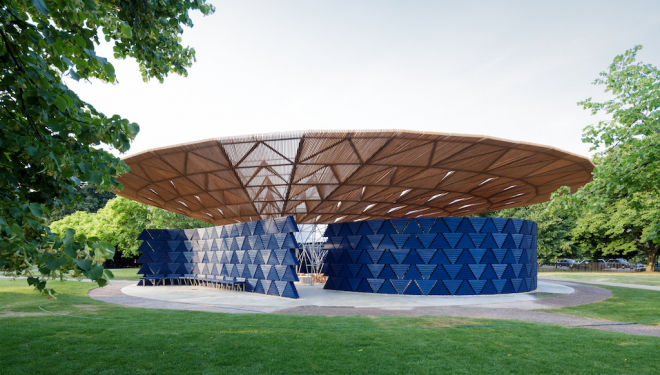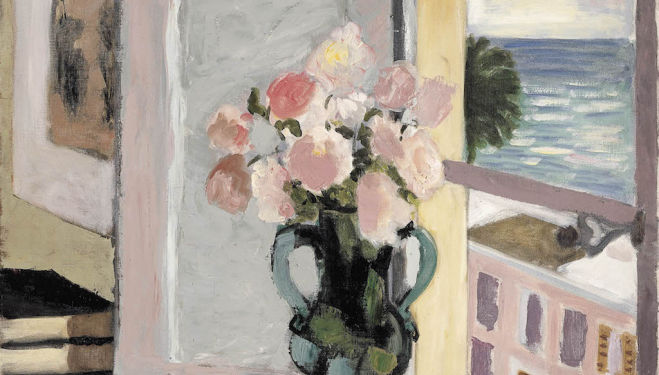
The Royal Academy’s latest exhibition offers us that longed-for glimpse. And it’s not a glimpse into any old studio; it’s a glimpse into the studio of a modern master: Henri Matisse. Matisse in the Studio considers the fluid interchange between the artist's personal collection of studio objects and the works inspired by them. In doing so, it exposes Matisse’s creative process for the first time for all to see.
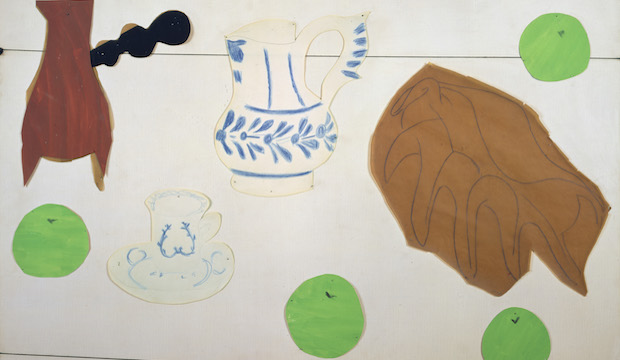
Henri Matisse, Still Life with Shell, 1940, Gouache, coloured pencil, and charcoal on cut paper, and string, pinned to canvas, 83.5 x 115 cm Private collection, Photo © Private collection © Succession H. Matisse/DACS 2017
Throughout his life, Matisse lived and worked in his studios. Overbrimming with eclectic treasures collected from home and abroad, they provided him with never-ending sources of inspiration; to Matisse, these intimate spaces and the objects within them were alive.
Writing to his wife in 1920, he declared: ‘these objects keep me company...I am not alone.’ He worked with them, valued them, drew them, painted them, photographed them, and above all lived with them. He revisited his sacred ‘palette of objects’ again and again. This, of course, is the premise of the show.
The opening room lays emphasis on two of his most treasured possessions: a chocolate pot, given to him by the artist Albert Marquet on the day of his marriage to Amélie Noellie, and a Venetian Rococo chair, described in a letter to Louis Aragon in 1942 as ‘the object for which I have been longing for a while’.
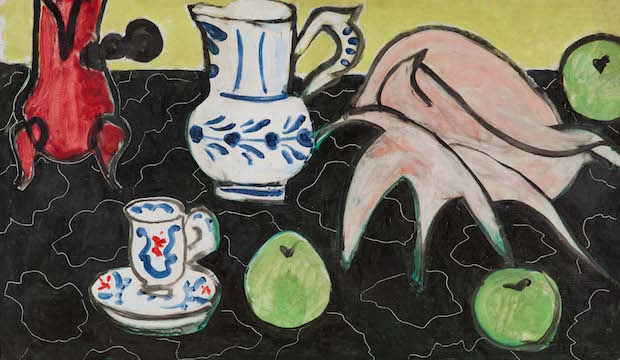
Henri Matisse, Still Life with Seashell on Black Marble, 1940, Oil on Canvas, The Pushkin State Museum of Fine Arts, Moscow, Photo © Archives H.Matisse, © Succession H.Matisse/DACS 2017
Both the chocolate pot and the Rococo chair have been sourced to support the exhibition; they are exhibited alongside the paintings, drawings, and collages they inspired. Bouquet of Flowers in a Chocolate Pot, 1902, on loan from the Musée Picasso, Paris, is one of the most breathtaking on display. It even caught the eye of Picasso, who bought the painting years later. The vibrant palette and traditional composition, isolating the chocolate pot filled with artificial flowers, is characteristic of Matisse's early Fauvist work.
The rest of the show continues in the same vein. We’re presented with the object, and then the work with the object in it. But, there is a little more subtlety to the presentation of the final suite of rooms, which is the exhibition’s curatorial masterstroke.
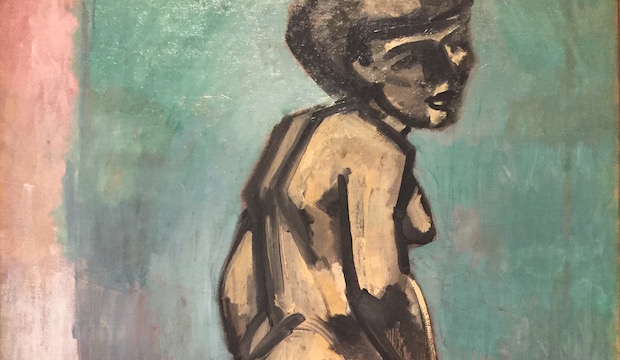
Henri Matisse, Standing Nude, 1906-07, Photo © Culture Whisper
It’s clear from the vast array of South East Asian, African, North African and Chinese artefacts, masks, fetishes and decorative items on display that Matisse looked far beyond the European canon for artistic inspiration.
Matisse is renowned today for challenging the naturalistic representation of the human body. Generally, Matisse's nudes are chopped, anatomically mismatched, bold rather than dainty. Features are strong and perspective distorted. Standing Nude, 1906-1907, is a prime example.
While Matisse’s prime source of inspiration for Standing Nude was a black and white photograph of a coquettish woman looking over her right shoulder, parallels have been drawn between the sitter's face and the oversized features of the tribal masks and sculptures collected by Matisse from various trips abroad.
It's probable that he turned to Muyombo for the figure’s face. The woman's features are pronounced, her nose and eyes are sharp. Matisse's impasto black outlines are thick, and the colour palette quite surreal – she’s sensual and disturbing at the same time, just like his masks.
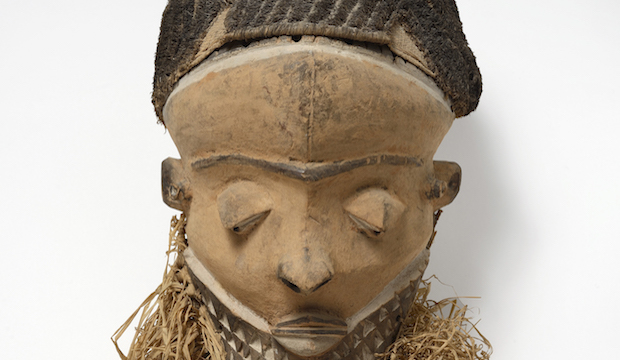
Muyombo mask, Pende region, Democratic Republic of the Congo, 19th-early 20th century, Muyombo mask, Pende region, Democratic Republic of the Congo, 19th-early 20th century, Wood, fiber and pigment, 49 x 19.3 cm, Former collection of Henri Matisse. Private collection, Photograph by Jean-Louis Losi
Beyond the individual case studies in the exhibition, collectively they provide a fascinating insight into his creative process. Preparatory collage cut-outs, created to map out future compositions, are exhibited alongside the finished piece. Showing the before and after creates the illusion of proximity – you are let into Matisse's stylistic secrets. Quite simply, you are drawn into his world. You may even come away thinking you know the man.
But as Matisse himself once declared: ‘the object is an actor. A good actor can have a part in ten different plays; an object can play a role in ten different pictures’. Yet unlike actors, his objects are inanimate.
Brought together in the Royal Academy's Sackler Wing, they offer a glimpse into the physicality of the studio – but they don’t reflect the passion, the energy and the anguish that ultimately brings a studio, theatre and final composition to life. So, we see only half the story; Matisse's compositional form may have been influenced by the objects around him, but his palette certainly was not. For his palette, the colourist drew stylistic inspiration from the great masters before him including Chardin, Watteau, and Manet amongst others.
Matisse was not alone in seeking inspiration from the world of things, but his world of things sparked a powerful imagination in a multitude of ways. Matisse in the Studio may not be a blockbuster exhibition, but it’s an exquisite insight into the mind of a Modern Master.
| What | Review: Matisse in the Studio, Royal Academy |
| Where | Royal Academy, Burlington House, Piccadilly, London, W1J 0BD | MAP |
| Nearest tube | Piccadilly Circus (underground) |
| When |
05 Aug 17 – 12 Nov 17, Saturday – Thursday 10am – 6pm, Friday 10am – 10pm |
| Price | £15.50 |
| Website | Click here to book via the Royal Academy |


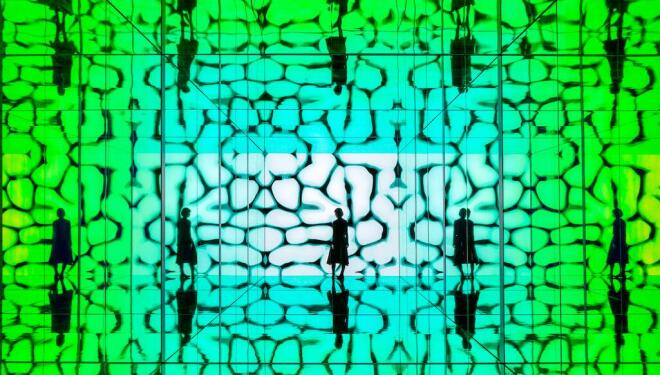
![Review: Cartier in Motion, The Design Museum [STAR:4]](/images/thumbs/cw-17496-660x375.jpg)
